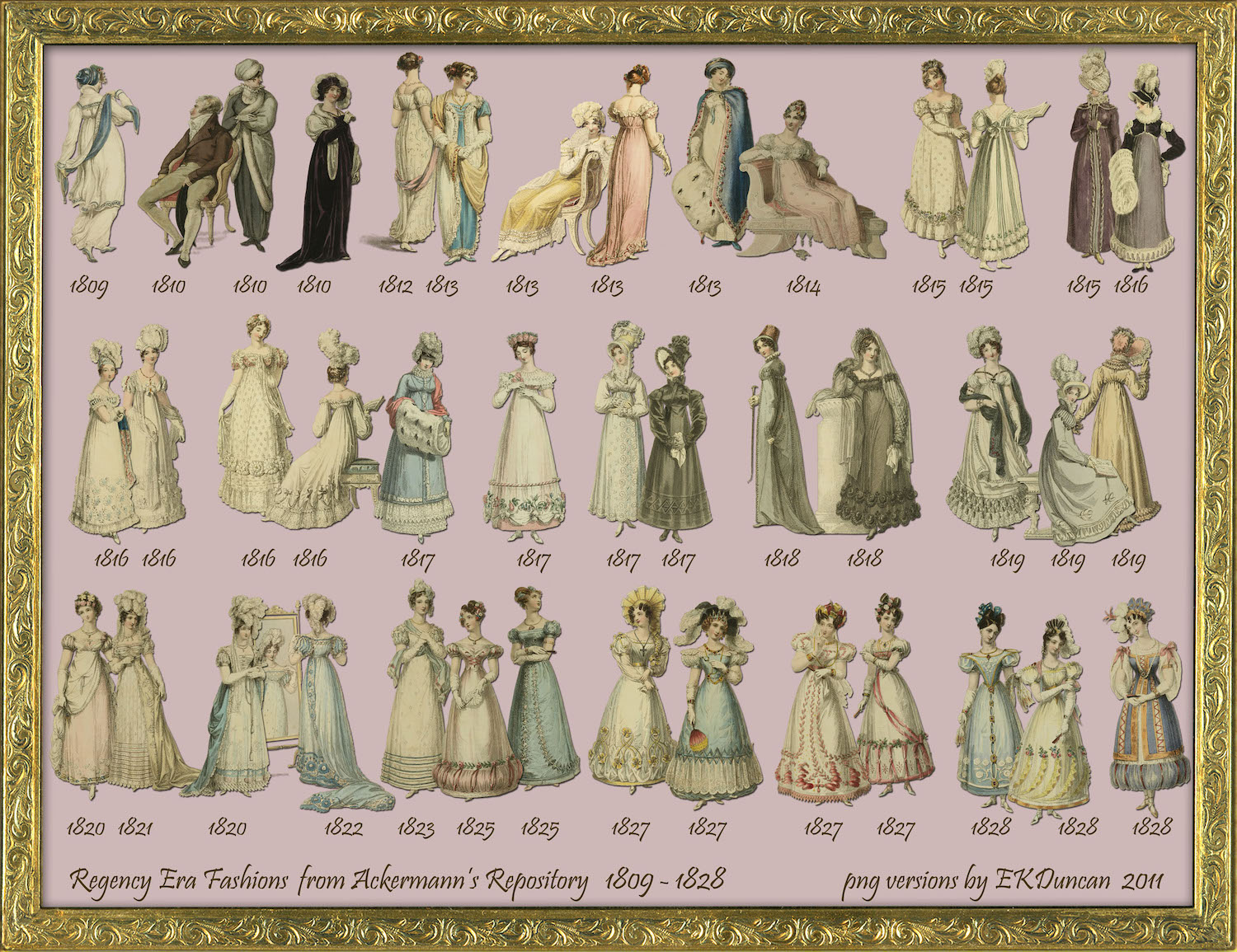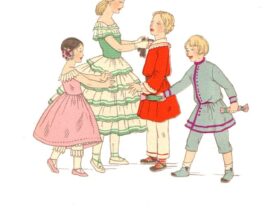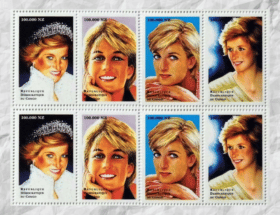By Pauline Weston Thomas
This page is about Empire dress and its influence on C19th Regency Era Fashion. Using fashion plate imagery, the page follows the changes in the female fashion silhouette from the late 1790s to 1825. The bulk of this epoch covers the era of fashionable Regency Dress, an era beloved by Jane Austen and costume re-enactment fans.
When Was the Regency Era?
The Regency fashion era refers to the period between 1811 and 1820, during which Prince George IV ruled as Prince Regent in Britain due to King George III's mental illness. However, in terms of fashion and cultural influence, the Regency style extended beyond these official dates, roughly from 1795 to 1837, overlapping with the late Georgian and early Victorian eras.
French Bonaparte's Influence on Fashion 1804
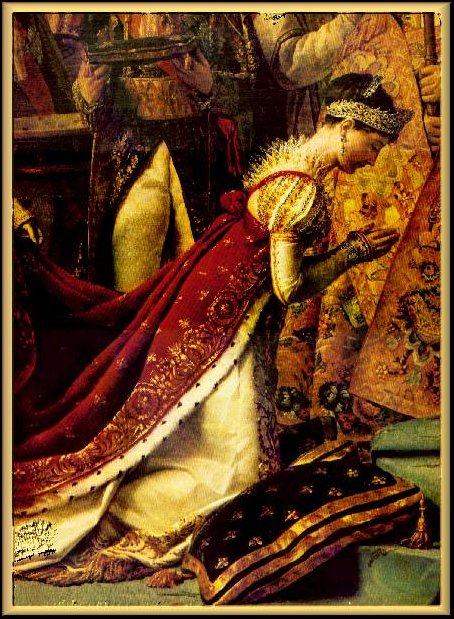
Napoleon Bonaparte crowned himself Emperor Napoleon I on the 2nd of December 1804 and was keen to make France a leader of fashion and an innovator of design and craft skills.
During the French Revolution, the French textile industry suffered and unlike in England, the use of textile machinery was nonexistent.
Emperor Napoleon stopped the import of English textiles and he revived the Valenciennes lace industry so that fine fabrics like tulle and batiste could be made there.
To make women buy more material he forbade them to wear the same dress more than once to court. Ladies' dresses had extra fabric gathered into the back and trains were seen again for the evening. Bonaparte also had fireplaces at the Tuileries blocked up so that ladies would wear more clothing.
Bonaparte was following a long tradition of promoting the French economy through fashion. Empress Josephine was a great fashion leader. She was an ideal model for the slender fashions of the day. Many of her Regency fashion dresses were designed by Leroy.
Bonaparte did not ignore men's rôle in the revival of the textile economy and he forced male military officials to wear white satin breeches on formal occasions.
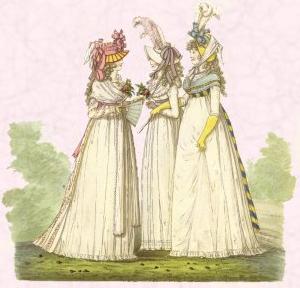
You can read more about how Louis XIV promoted fashion in an earlier era when he sent fashion dolls to European courts.
The Empire Dress Style 1800
The high-waisted graceful styles of the early 19th century are known as the Empire style. The Empire dress which evolved in the late 1790s began as a chemise shift gathered under the breasts and at the neck.
By 1799 the empire line silhouette shown left was well established and is the line we associate with dress of the early 1800s.
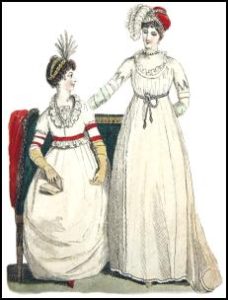
The costume history plate of 1800 shown above, is a good example of how the fullness of the muslin shift dress was first drawn together under the bustline with a girdle. The volume in the skirt is still great and bears a relationship with fuller skirts of the 1790s shown above.
Named after The First Empire, by 1800 the gown silhouette had a very décolleté low square neckline as seen above, a short narrow backed bodice attached to a separate skirt.
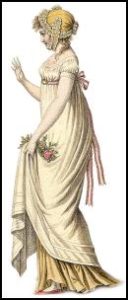
Frequently the small neat puff sleeves barely capped the shoulder. They were pulled back by the narrow cut of the bodice and this restricted arm movement to a certain daintiness.
You are reading an original Regency Dress Era 1800-1825 Fashion History article by Pauline Weston Thomas at www.fashion-era.com Copyright 2001-2022 ©
The Chemisette
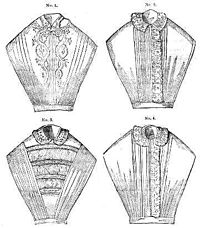
Regency dress in the period 1800-1820 was based on classical principles of flowing Grecian robes. For modesty until 1810 a tucker or simple chemisette (a side opening half blouse) filled the bare neckline by day.
Underwear of 1800

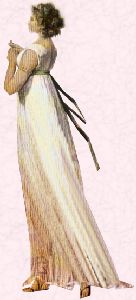

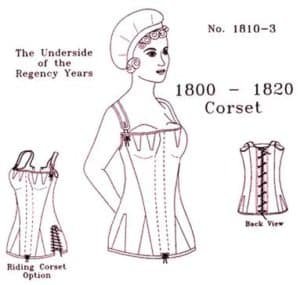
The soft muslin dresses of 1800 clung to the body highlighting the natural body outline so stays were unpopular unless the figure demanded them.
These Empire fashions at the turn of the century were often little more than sheer nightgowns. The practical solution to the discomfort of lighter clothing was to simply adopt the warm undergarments called pantaloons and already worn by men.
Flesh Toned Pantaloons
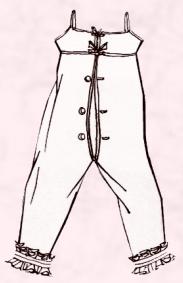
The pantaloons were made of light stockinet in a flesh-toned nude color and reached all the way to the ankles or to just below the knee. This is why Empire women often appear to be wearing no underwear when seen in paintings of the era.
The flesh-tone pantaloons acted in just the same way under clothes as they do today when a woman wears a flesh-toned bra and briefs under white or pastel trousers and top.
Later it became fashionable to wear a white or pastel slippery silk satin slip over the stays making the dress silhouette quite smooth. To support extra skirt fullness a small bustle pad lifted the dress back.
Fabrics for the Empire Line Dress
The fabric for Empire Line dresses was usually fine white lawn, muslin, or batiste.
Although muslins were less costly than silks, good white work embroidered lawn fabrics still cost money. Muslin also laundered better than silks, but the white muslins still needed a great deal of attention to keep them looking pristine and clean.
Regular wearing of white gowns was a sign of social status as white soiled so easily. White gowns generally were kept for the evening and in the day pastel or colored robes were thought more suitable.
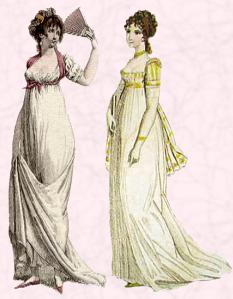
Right - Dress of 1800 The Lady's Monthly Museum 1800.
In winter heavier velvets, cotton, linens, fine wools, and silks were used and sometimes extra warmth came from flannel petticoats or full under-slip dresses.
You are reading an original Regency fashion history article about Empire dresses between 1800-1825 by Pauline Weston Thomas at www.fashion-era.com Copyright 2001-2022 ©
Decoration That Helps Identify and Date Dresses 1800-1825
The classical decoration was inspired by images of Grecian ladies from original Greek art.
To help you date costumes in prints, paintings, and productions it is useful to understand that the classical line was debased by other types of decoration depending on fashion influences. For example, Napoleon's expeditions to the East and items brought back by him and other soldiers created interest in Egyptian ornamentation.
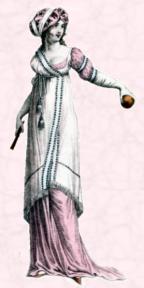
Classical Grecian Decoration on Dress 1800-1803
Between 1800 and 1803 classical ornament used geometric shapes.
Greek key patterns decorated borders and garment hems, sleeve bands, and shawls. All the embroidery was initially delicate and light, faithfully following the classical influence, but eventually, the embroidery became coarsely executed.
Egyptian Ornament on Classical Dress 1804-1807
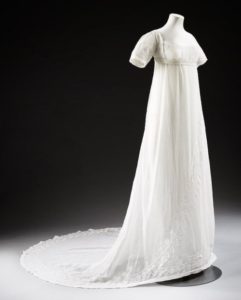
One of the problems of such simple classical silhouettes was their very simplicity. This soon led to boredom and decorative innovation as the restraint of staying pure in plain classical robes was too much for some.
Between 1804 and 1807 the classical robes developed an eastern exotic feel with Etruscan and Egyptian decoration with woven or embroidered borders on fabric lengths and on stoles. The eastern patterns first appeared from gifts Napoleon gave to his Empress Josephine after his visits to Egypt.
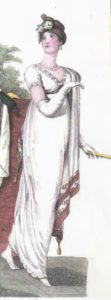
Soon everyone copied the items. Empress Josephine was an icon and fashion leader of her time.
This Empire Line muslin gown shown right and from 1807 has an appropriate border. The border is emphasized on the coordinating shawl, complete with tassels.
European and Military Influence in Decoration 1808
A la Mameluke Sleeves
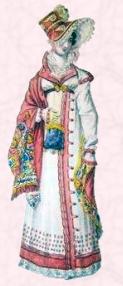
After 1808 Spanish ornament featured on robes and appeared as slashed areas and tiered sleeves. When sleeves covered the hand they were called à la mamelouk. Image examples here illustrate this extra long sleeve length.
The Napoleonic Wars meant that a soldier's uniform had high visibility and military-style details featured on clothing for both sexes.
Frogging, braids, cords, velvet, and other trims lent a topical jaunty dashing air to many a garment, especially outdoor wear.
Peasant influence from European dress was particularly applied to the name of coats, cloaks, and mantles such as the Witzchoura redingote an empire cloak of Russian origin.
The most usual coat in the Regency era was the Pelisse coat.
The Pelisse 1800-1850
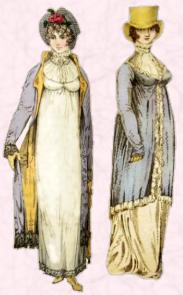
The Pelisse can be a confusing term because there were several forms over a 50-year period. The first form of pelisse worn from 1800 to 1810 was an empire line coat-like garment to the hip or knee.
After 1810 it was worn full length and was a warmer longer-sleeved coat than the Spencer, but often made of the same materials.

It was usually fur trimmed, straight in cut, belted at a high waist like the gown and sported a broad cape-like collar an influence of military styles. The colors for the pelisses were golden brown, dark green, and blue. The Pelisse was normally worn over pale gowns which were visible as it was worn open at the front.
From 1818 onwards women wore a coat dress variation called a pelisse-robe. It could be suitable for indoors or outdoors and was essentially a sturdy front fastening carriage, walking, or day dress.
You are reading and original Regency Dress Era 1800-1825 Fashion History article by Pauline Weston Thomas at www.fashion-era.com Copyright 2021 ©

Right - Decorated Pink Pelisse Coat.
The Gothic Influence 1811

By 1811 in Britain, the influence of the Middle Ages, termed Gothic crept into dress styles debasing the pure classical lines. The bodice gained more shaping and could be paneled. It was not cut as tight and narrow as in the first decade of the century, so it made the shoulder line broader and the dress more comfortable to wear.
The flowing medieval touches soon broadened to include Tudor and Elizabethan times with ruffed and Vandyke triangular pointed decoration and cross-over bodices. In England, copious trimmings on skirts were all the rage from flounces and padded rolls to pleated, fanned, and tucked trims.
Embellishment was according to the latest fashion which sometimes took its own course due to the hostilities between France and Britain.
By 1820 the dress had lost all classical form and took on a pure Gothic line which lasted until Queen Victoria's accession.
Variations in Fashion Between France and England 1808-1814
In wartime between 1808 and 1814, the female waistline lengthened in England. English ladies really had little idea of what was happening to Paris fashion.
Skirt Style 1815
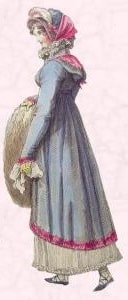
When visitors from Britain returned to France after the 1814 peace treaty they were amazed that fashions were so different. In Paris, waists were worn very much higher than in those of Regency England and skirt hems were wider, more A-line, padded, and decorated.
British fashion soon followed the French lead after the French ridiculed the English dresses in cartoons making them appear very ugly with bulbous tulip round-waisted skirts and solid corsetry.
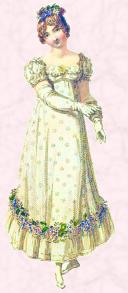
Rise and Fall of the Waistline 1815-1825
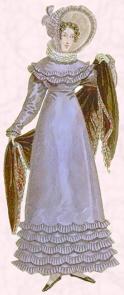
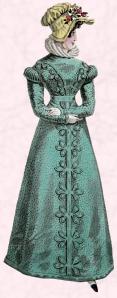
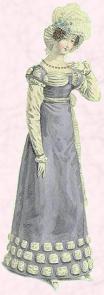
In 1815 with the Napoleonic wars over, Britain began to follow French fashion trends for wearing a high waistline.
The waistline reached its peak height in 1816-17 when the line fell directly under the breasts.
Almost as soon as the waist had risen, 1818 fashion plates began to show the waistline dropping and tightening. It continued to drop annually by an inch until by 1825 it was at last in its normal position.
All these wider skirt silhouettes show decorative interest, an ornamentation in keeping with Gothic over embellishment.
You are reading and original Regency Dress Era 1800-1825 Fashion History article by Pauline Weston Thomas at www.fashion-era.com Copyright 2022©
Anglomania
Leroy the French designer had to follow the whims of his clients and drop the dress waists and widen the skirts. It seems that French ladies soon preferred the English style. Anglomania began to sweep France.
After 1820 as the neat slim waist emerged, corsets were worn again by all women. The narrower buckle belted day waist or sash-wrapped evening waist was balanced by widening skirts which were often horsehair padded and frilled to make them stand away from the legs.
By 1824- 1825 the wider skirts were balanced by a wider shoulder line with a leg of lamb sleeve often known as a gigot sleeve as seen in the central pink dress.
This had begun as a short sleeve that had been covered over by a transparent or semi-opaque sleeve as the pastel pink evening dress shows, and eventually, such sheer sleeves became a solid fabric.
The semi-opaque sleeve was the forerunner of all manner of fancy sleeve styles setting the scene for more romantic dress styles of the 1830s.
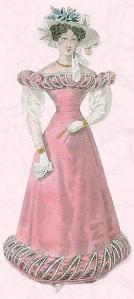


Earl Spencer and the Short Spencer Jacket 1795
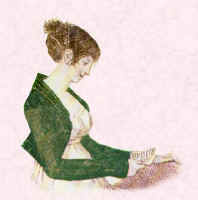
The Spencer was a short top coat without tails worn by men during the 1790s as an extra covering over the tailed coat. It had long sleeves and was frequently decorated with military frogging. Its originator is thought to be Earl Spencer who singed the tails of his coat when standing beside a fire. He then had the tails trimmed off and started a fashion.
A female version was soon adopted by gentlewomen who at the time were wearing the thin light muslin dresses of the 1790s.
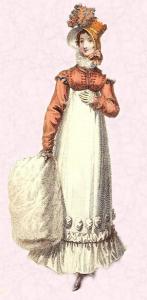
The Spencer was worn as a cardigan or shrug is worn today. It was a short form of jacket to just above waist level cut on identical lines to the dress.
Regency Spencers
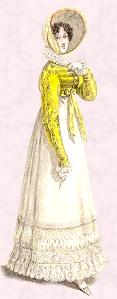
The Spencer was worn both indoors and outdoors and for eveningwear and was made of silk or a wool material known as kerseymere.
When it was worn as an indoor evening Spencer it was called a canezou.
Spencers stayed in fashion for about 20 years whilst the waistline remained high.

This lemon Regency Spencer is from a fashion plate of 1818. This Spencer also has Gothic and military overtones with its decorative work. Areas of Spencers' back and front were decorated with braids and cording. Italian quilting was popular as it created a raised surface pattern.
When the waist slowly began its drop on dresses so did the waist of the Spencer as in this illustration of the cerise Spencer circa 1820.
Military Touches

As the fashion for military touches persisted, many Pelisses and Spencers were covered in decorative braids, tassels, frogging, and cords, as a result, their wearers looked like members of the Hussars.
In time, a short jacket similar to a decorated Spencer was called a Hussar jacket.
You are reading an original Regency Dress Era 1800-1825 Fashion History article by Pauline Weston Thomas at www.fashion-era.com Copyright 2025©
The Redingote 1818
The Redingote was worn from 1818 onwards initially indoors in cold weather, worn open whilst revealing the dress beneath. Its name derives from the 18th-century version of a riding coat. It was used in place of a loose cloak and as it developed a series of shoulder capes it became very suitable for travel. As dresses widened so the Redingote widened.
Redingotes were usually trimmed with fur and mostly made of heavy dark cloth.
See a timeline of the redingote.

1800-1825 is it Late Georgian, Regency, or Both?
The period 1800-1837 is part of the Georgian era. George III, insane after 1811, lived on until 1820. His son the Prince Regent, George, already a cause celebre acted as Regent for nine years of the King's madness and then reigned himself from 1820-1830.
Because of the influence of the Georgian Prince Regent, this is known as The Regency Period, or the Regency fashion era. Because of some overlap due to the acknowledged prominence of the Prince in court consider the Regency era to begin in 1807.
Original Page Concept 2001, Updated Aug 2022
You have been reading an original Regency fashion history article about dresses between 1800-1825 by Pauline Weston Thomas at www.fashion-era.com Copyright 2001-2025 ©
